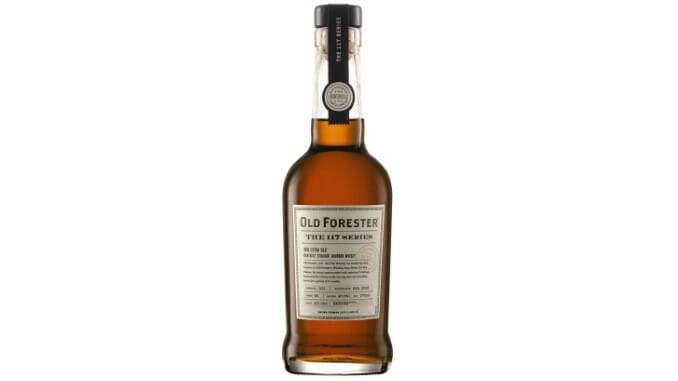Old Forester The 117 Series 1910 Extra Old Bourbon
Photos via Old Forester/Brown-Forman Drink Reviews whiskey
In recent years, the Old Forester brand has gone from being a relatively unchanging and timeless classic bourbon, to a hotbed of constant experimentation and new limited releases. Core to these releases has been the creation of The 117 Series, a 375 ml playground for Master Taster Jackie Zykan to concoct new releases that explore various aspects of the classic OF flavor profile. To date, the two previous releases in The 117 Series have examined the effects of barrels with a very high percentage of “angel’s share,” or barrels from a specific aging warehouse, Warehouse K. The newest entry in The 117 Series, on the other hand, evolves an existing Old Forester brand in a fairly dramatic way.
That whiskey is 1910 Extra Old Bourbon, being essentially a more matured version of their existing Whiskey Row staple Old Forester 1910. The thing that makes 1910 unique in the first place is the secondary oak maturation it undergoes in proprietary, deeply charred barrels—blackened almost to the point of disintegration. 1910 Extra Old, on the other hand, makes that secondary finishing period much longer, at 18 months. What you end up with is a bourbon that has been deeply transformed by entering into a virgin, newly charred barrel for an even longer period of time. Like the core 1910, it’s bottled at a more approachable 46.5% ABV (93 proof), which is a major departure for The 117 Series, as both High Angel’s Share and Warehouse K had been released at 110 proof. Like the other releases, this is a limited bottling, in 375 ml bottles, released primarily in Kentucky and select online sales at an MSRP of $50.
The question here, then, is how that extra-long period of maturation in the deeply charred barrels affects OF’s bourbon. Let’s get to tasting and find out.
Visually, the effect of that secondary maturation is quite clear—this is very dark stuff with an almost auburn coloration to it. On the nose, the first thing my brain immediately snapped to was one of my favorite random snack foods: candied pecans from Trader Joe’s. There’s a sweet nuttiness to this, with a dusting of cinnamon, and cacao nib-like nuttiness as well. Flamed citrus and sheer roastiness follow behind, suggesting an Ethiopian Yirgacheffe-like coffee quality.
On the palate, this is naturally oak forward and roasty, with some trailing tannin but no overbearing bitterness to speak of, which is nice. I’m getting espresso, slightly smoky at times, with a bit of clove spice and dark chocolate brownie. There’s some residual sweetness, which is mild to moderate, but at the end of the day it doesn’t read as super rich or decadent. Nor is it overtaken by the oak—just moderate, well-tempered notes of roast and wood. It’s simultaneously more approachable than previous installments in The 117 Series, thanks to its lower proof, but perhaps a bit less boldly unique than its predecessors. I can’t help but think that some bourbon geeks will feel cheated in some way by any lower proof point than they’re used to, but it does work well for this profile, which remains quite easy to drink and enjoy throughout.
At the end of the day, this isn’t the most exotic entry in The 117 Series, but not every entry in said series can always aspire toward one-upping the last one in the novelty factor. I will say, as I’ve commented before, that I like the fact that this series comes in 375 ml bottles, which both increases the number of available bottles (thus getting it to more people) and allows for a reasonable MSRP for a “special release,” at a time when bourbon is increasingly becoming prohibitively expensive. If “extra roasty” is your thing, then this is a bottle you’ll want to be hunting down.
Distillery: Old Forester (Brown-Forman)
City: Louisville, KY
Style: Kentucky straight bourbon whiskey
ABV: 46.5% (93 proof)
Availability: Limited, 375 ml bottles, $50 MSRP
Jim Vorel is a Paste staff writer and resident liquor geek. You can follow him on Twitter for more drink writing.